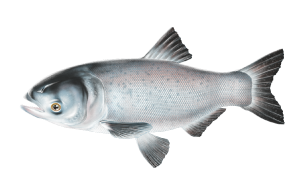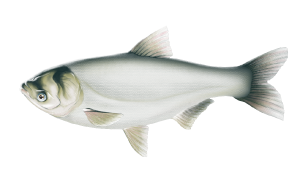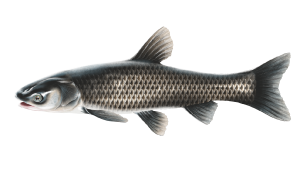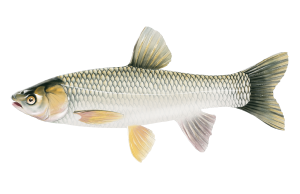Asian carps is the collective term that refers to four species of carp:
These four species are part of the Cyprinid family and are related to several varieties of minnows. They are all native to the rivers, reservoirs and lakes of China and southern Russia.
Introduction
Asian carps were introduced to the Southern U.S. in the late 1960’s and 1970’s for use as biological control in aquaculture facilities based on their specific diets. Flooding events allowed at least three of the four species (Bighead, Silver, and Black carps) to escape these facilities and eventually make their way into the Mississippi River Basin. The spread of Grass Carp has largely been the result of stocking for the purposes of aquatic vegetation control.
Establishment
Silver and Bighead carps have established populations throughout the Mississippi River Basin and are now in the Illinois Waterway and within striking distance of Lake Michigan and the Great Lakes. Black Carp are spreading towards the Illinois River, recent evidence has found natural reproduction of Grass Carp in two U.S. tributaries of Lake Erie, which is an immediate threat to Lake Erie.
There are currently no established populations of Asian carps in the Canadian waters of the Great Lakes.
Impacts
These fish are of concern because of the damage they could cause to Canada’s ecological, recreational and economic environments if they established in the Great Lakes. In the absence of adequate prevention, it is predicted that Asian carp will eventually reach the Great Lakes.
- Asian carp prefer cold or moderate water temperatures, like that of the Great Lakes, and they reproduce quickly.
- Asian carps can consume up to 40% of their body weight in food each day, grow more than 25 cm during their first year, and reach a weight of 40 kg and a length of more than one meter once they have reached maturity .
- Bighead Carp and Silver Carp feed on plankton, which constitute the very base of the food chain in the aquatic environment, and spread very quickly.
- The vibrations in the water excite Silver Carp, which causes them to jump out of the water at a height of up to three meters (nine feet). Due to the vibrations caused by the propellers of the boats, the Silver Carp has become a danger for boaters and water skiers; these carp have already caused serious injuries in recreational users.
Timeline
The map below shows occurrences of Asian carps, not established populations. Occurrences are individual captures of a fish that may be sterile or fertile.
Asian carps are introduced to North America for use in the aquaculture industry. The four species of Asian carp are bighead carp, black carp, reed carp and silver carp. In Canada, bighead carp and reed carp are imported and used as live food for the fishing industry.
Asian carp may have escaped from the containment basins and started to invade freshwater systems following flooding in the southern United States in the 1970s and later. Adapting quickly to the natural environment, two species of Asian carp, the bighead carp and the silver carp (together called bighead carp) begin their migration north by the Mississippi basin.
After a major flood in the Illinois River region and the subsequent recession of the waters, dead Asian carp are nine times more numerous on the banks than all the native fish. This is a warning that Asian carp have invaded the area, and authorities are realizing that this is a significant problem.
Canada is participating in two Asian carp summits held in Chicago to propose strategies to prevent Asian carp from entering Lake Michigan.
Fisheries and Oceans Canada is conducting a risk assessment to determine the likelihood of Asian carp arriving in Canadian waters, surviving there, breeding there, spreading there and the impact this could have on Canadian waters. The study found that the risk is high in most parts of Canada, including the southern Great Lakes basin.
Fisheries and Oceans Canada scientists are beginning to participate on an ongoing basis in the development of the American Asian Carp Control and Management Plan, and to participate in a prevention subgroup.
Based on the risk assessment, Ontario is amending its regulations to prohibit the sale or possession of live Asian carp.
Canada undertakes “lightning” border controls and intercepts several cargoes entering the country by land and air, in which live Asian carp are found. Canadian representatives have since worked with several partner organizations to provide training, provide equipment and establish protocols to facilitate this monitoring.
Asian carp DNA is discovered during surveillance activities in the Chicago sanitary and naval canal, 10 km from Lake Michigan. Big-headed carp are therefore much closer to the Great Lakes basin than previously thought. When decommissioning for routine maintenance of the electrical barriers used to control the movement of fish in this waterway, Canada provides equipment and expertise to assist in containment efforts to prevent the migration of Asian carps to the Great Lakes through the Chicago sanitary and naval channel.
Work begins on a Strategic Action Framework for Asian Carp Control to put in place a series of short-term and long-term measures to limit the spread of bighead carp and carp. to prevent the arrival and establishment of these species in the Great Lakes.
British Columbia prohibits the possession and sale of Asian carps.
Fisheries and Oceans Canada announces the start of the “Binational Ecological Risk Assessment of Big-headed Carp for the Great Lakes Basin”. The report, which describes the likely pathways for the introduction of silver and bighead carp into the Great Lakes, facilitates the development of immediate and effective action against emerging threats to Canadian waters. The study is led by Fisheries and Oceans Canada and coordinated by the Great Lakes Fishery Commission.
The provincial government of Ontario and the federal government are working together in simulations to verify the rapid response framework and communication systems of the Ministry of Natural Resources and Forestry. These frames are designed to be used in the event that Asian carp are found in the Canadian Great Lakes.
Fisheries and Oceans Canada and the Ontario Ministry of Natural Resources and Forestry are officially members of the United States-led Asian Carp Regional Coordinating Committee.
The Binational Ecological Risk Assessment of Big-headed Carp for the Great Lakes Basin by Fisheries and Oceans Canada has been completed. The results provide scientifically defensible, peer-reviewed advice to determine the most effective measures that the two countries could take to mitigate the risk of introducing these species to the Great Lakes.
The Government of Canada announces that it will spend $ 17.5 million over the next five years on carp prevention, early warning, response and management Asian. With this funding, Fisheries and Oceans Canada is embarking on the development of a new Asian carp program.
Canada continues to work closely with its American counterparts to develop a comprehensive early warning and surveillance system. “The Great Lakes are the largest freshwater ecosystem in the world and are one of Canada’s most precious resources. We are committed to working with our American counterparts to continue to protect the Great Lakes basin. Together, these measures will go a long way toward achieving our ultimate goal: preventing Asian carps from entering and settling in the Great Lakes. The Honorable Keith Ashfield, PC, MP
Fisheries and Oceans Canada confirms two separate captures of live reed carp in the Grand River near Lake Erie in the Dunnville area of Ontario. Fisheries and Oceans Canada and the Ontario Ministry of Natural Resources and Forestry are taking action. It is confirmed that the two specimens are sterile, which leads to the conclusion that they are probably fish having been the object of sowing.
The same year, the United States Geological Survey published a report demonstrating the presence of reed carp able to reproduce in the Sandusky River, in Ohio, which flows into Lake Erie.
Fisheries and Oceans Canada is undertaking work to assess the ecological risk posed by reed carp in the Great Lakes.
Researchers from Fisheries and Oceans Canada in Burlington are also beginning to develop and test new methods to control the movement of live fish using sound barriers and water pressure. Native fish with behavior similar to that of Asian carp are used in the trials.
In the United States, the Army Corps of Engineers is submitting a report to Congress outlining solutions to prevent the migration of Asian carps and other invasive species between the Great Lakes and Mississippi river basins. The Great Lakes and Mississippi River Interbasin Study (GLMRIS) report presents a wide range of options and technologies, as well as cost estimates. According to the report, any impact on Canada, even a relatively minor one, may require coordination with Canada.
Ontario is introducing the Invasive Species Act to support the early prevention, detection, response and eradication of invasive species in the province.
Quebec becomes a member of the Asian Carp Regional Coordinating Committee.
Fisheries and Oceans Canada completes construction of a new Asian carp laboratory at the Canada Center for Inland Waters in Burlington, Ontario. A second Fisheries and Oceans Canada laboratory, located in Winnipeg, is being upgraded to carry out environmental DNA testing.
Although the population of bighead carp in the Mississippi River basin is increasing rapidly in terms of size and range, its rate of expansion is not well understood. In 2006, a study was carried out in the La Grange passage of the Illinois river, where the presence of populations of bighead carp has been documented since 1993. In this study, radio telemetry was used to track the movements of bighead carp in the river. Radio transmitters were surgically implanted in several adult fish in June 2003 and from May to July 2004.
The average movement rate of adult bighead carp was found to be high, more than 1.7 km per day; one of the individuals traveled 163 km in 5 weeks. This shows that the distribution of adult bighead carp can increase rapidly, especially in spring and summer. Downstream travel rates were found to be higher (0.5 km per day) than upstream travel rates. Since no difference was noted between the upstream and downstream movement rates at high river flow and at low river flow, the authors attribute the difference to the fact that the carp swims faster when it follows the flow.

1960s to 1970s
1990
1996
2002
2003-04
2005
2008
2009
2010
2011
2012
2013
2014
2015
2016
2017
2018
2019
1960s to 1970s
Asian carps are introduced to North America for use as biological control in the aquaculture industry. The four species of Asian carp include Bighead, Black, Grass, and Silver carps.
Flooding in the southern United States in the 1970s and onward likely results in Asian carps moving beyond their contained environments into open freshwater systems. Adapting quickly to the natural environment, two of the species, Bighead and Silver carps (together termed “bigheaded carps”) begin moving northward through the Mississippi Basin.
Grass Carp are intentionally stocked in ponds and other waterbodies across the United States for vegetation control. Research on sterilization techniques for Grass Carp commences and by 1985, stocking of triploid fish (which are unable to reproduce) starts to be adopted by some states.
1996
The United States National Invasive Species Act authorizes the United States Army Corps of Engineers to construct a demonstration electric dispersal barrier on the Chicago Sanitary and Ship Canal. This is done to prevent inter-basin establishment of gobies and subsequently Asian carps and other aquatic invaders between the Mississippi River Basin and the Great Lakes.
2003-04
Canada participates in two Asian carp summits held in Chicago to consider strategies to prevent the entry of Asian carps into Lake Michigan.
Fisheries and Oceans Canada (DFO) conducts a Risk Assessment to evaluate the likelihood of survival, reproduction, and spread of Asian carps in Canadian waters, should they be introduced; and to determine the potential impacts of these events. The study concludes that the risk is high in some parts of Canada, including the southern Great Lakes basin.
Fisheries and Oceans Canada Science staff begin participating in the development of the United States Asian Carp Control and Management Plan, and in a prevention subgroup.
2009
Asian carp environmental DNA is discovered during monitoring exercises in the Chicago Sanitary and Ship Canal, 10 km from Lake Michigan. This leads agencies to believe that bigheaded carps could be much closer to the Great Lakes basin than previously thought. However, it is important to note that this environmental DNA could have originated from a wide variety of sources (e.g., transfer from a ship) and does not imply that a live fish was necessarily present at this location. During a scheduled shutdown for routine maintenance of the electrical barriers which control fish movement through that waterway, Canada contributes equipment and expertise toward containment efforts to prevent Asian carps from passing through the Chicago Sanitary and Ship Canal into the Great Lakes.
Development of an Asian Carp Control Strategy Framework begins and sets forth a series of short- and long-term actions to control the spread of Bighead and Silver carps and prevent their introduction and establishment in the Great Lakes Basin.
Updates to the pre-existing electrical barrier are implemented and a second electric barrier becomes operational.
2010
The Province of British Columbia bans the possession and sale of Asian carps.
Fisheries and Oceans Canada announces the launch of the “Bi-national Ecological Risk Assessment of Bigheaded Carps for the Great Lakes Basin”. The assessment is led by Fisheries and Oceans Canada and coordinated by the Great Lakes Fishery Commission.
2011
The Province of Ontario and Fisheries and Oceans Canada collaborate in mock exercises to test the Ministry of Natural Resource and Forestry’s Rapid Response Framework and communication systems. These frameworks are designed to be used in the event that Asian carps are discovered in the Canadian Great Lakes Basin.
Fisheries and Oceans Canada and the Ontario Ministry of Natural Resources and Forestry (MNRF) officially sign on as members of the US-led Asian Carp Regional Coordinating Committee (ACRCC).
The Fisheries and Oceans Canada-led “Bi-national Ecological Risk Assessment of Bigheaded Carps for the Great Lakes Basin” is completed. This report identifies likely routes where Silver and Bighead carps could enter the Great Lakes and assists in the preparation of immediate, effective actions against emerging threats to Canadian waters. It also provides scientifically defensible, peer-reviewed advice for determining the best courses of action by both countries to reduce the probability of introduction of these species into the Great Lakes.
The third electric barrier is placed into full-time operation.
2012
The Government of Canada announces that $17.5 million will be allocated over the next 5 years for the prevention, early warning, response and management of Asian carps. As a result of the funding, Fisheries and Oceans Canada initiates the development of a new Asian Carp Program.
Canada also continues to work closely with American counterparts to develop an extensive early warning and surveillance system.
2013
Fisheries and Oceans Canada confirms two separate captures of live Grass Carp in the Grand River near Lake Erie. The response is undertaken jointly by Fisheries and Oceans Canada and the Ontario Ministry of Natural Resources and Forestry. Both Canadian specimens are confirmed to be sterile, leading to the conclusion that they were likely stocked individuals.
This same year, the United States Geological Survey (USGS) publishes a report showing evidence of reproducing Grass Carp in the Sandusky River in Ohio, a river that empties into the western basin of Lake Erie.
Fisheries and Oceans Canada begins work to assess the ecological risk of Grass Carp in the Great Lakes.
Fisheries and Oceans Canada researchers in Burlington also begin developing and testing new methods for controlling the movements of live fishes using sound and water pressure curtains. Native and non-native fishes that share similar behaviour to Asian carps are used for testing purposes.
2014
The United States Army Corps of Engineers submits a report to the United States Congress outlining alternatives to prevent Asian carps and other invasive species from transferring between the Great Lakes and Mississippi River basins. The Great Lakes Mississippi River Interbasin Study (GLMRIS) Report includes a comprehensive range of options and technologies, along with estimated costs. According to the report, any impacts to Canada (e.g., flooding risks, water quality issues), even relatively minor ones, may require coordination with Canada.
The Province of Ontario proposes the Invasive Species Act to support the prevention, early detection, rapid response and eradication of invasive species in the province.
The Province of Québec (le Ministère des Forêts, de la Faune et des Parcs; MFFP) joins the ACRCC.
Fisheries and Oceans Canada completes construction of a new Asian Carp Laboratory in Burlington, Ontario at the Canada Centre for Inland Waters.
Fisheries and Oceans Canada’s Asian Carp Program captures a third Grass Carp in the Grand River; it is found to be sterile.
2015
A total of nine Grass Carp are found in Canadian waters, eight in Lake Ontario and one in Lake Erie, by federal and municipal agencies, commercial fishers and an angler. Five are fertile. This marks the first captures of Grass Carp in Canadian waters of Lake Ontario.
Fisheries and Oceans Canada begins development of a formal response plan using the Incident Command System to respond to all verified captures or sightings of Asian carps in Canadian waters, in coordination with MNRF.
2016
Following the report of a Grass Carp angled from a private lake, a joint multi-agency response with Fisheries and Oceans Canada and the Ontario Ministry of Natural Resources and Forestry results in the capture of 10 Grass Carp, two of which are fertile. An additional Grass Carp is captured by a commercial fisherman in Canadian waters of Lake Erie.
The University of Toledo and USGS confirm that the eggs collected in the Sandusky River in 2015 are Grass Carp eggs.
2017
A binational ecological risk assessment to determine the extent of the risk of Grass Carp to the Great Lakes basin and to provide useful, scientifically defensible advice on prevention, monitoring, early detection, and potential management actions for managers and decision-makers in Canada and the United States, is released.
A single Silver Carp is captured by a contracted commercial fisherman past the electric barriers, 14 km from Lake Michigan.
The same year, a dead Grass Carp washes up on the shore of the Grand River in Ontario; someone walking by reports it and Fisheries and Oceans Canada collects it for analysis.Finally, a Grass Carp is caught in a commercial fishing net in Sarnia; it is found to be triploid (sterile).
2018
Three Grass Carp are captured in commercial fishing nets in Ontario; two from Point Pelee (Lake Erie) and one from Sarnia (Lake Huron). All are determined to be triploid (sterile).
A binational risk assessment for Black Carp has been scoped and the associated research to feed into the risk assessment is well underway. This work is coordinated by the Great Lakes Fishery Commission and the expert authors are from Fisheries and Oceans Canada, USGS, and the U.S. Fish and Wildlife Service (USFWS).
2019
A socio-economic risk assessment of the presence of Grass Carp in the Great Lakes basin, which provides a detailed analysis of the potential economic impacts of the establishment of Grass Carp in the Great Lakes, is released.
USGS confirms natural reproduction of Grass Carp in a second United States tributary of Lake Erie, following the discovery of larval Grass Carp in the Maumee River in Ohio.
No Grass Carp are captured in Canadian waters this year.





















